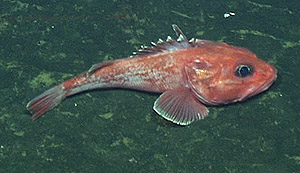
|
|||||||||||||||
|
| |||||||||||||||
A tough time of year for microscopic algae The storms of January and February make life very difficult for the microscopic drifting algae (phytoplankton) that support most life in the sea. Storm waves and southerly gales churn the ocean and cause downwelling, which carries these tiny algae far below the surface, where they cannot get enough sunlight to survive. To make matters worse, the ocean contains very little of the dissolved nutrients that act like fertilizer for phytoplankton. The net result is that most phytoplankton either die off or go dormant. In either case, their tiny cells sink down toward the muddy seafloor. This leaves very little food near the sea surface for grazing animals such as copepods and sardines. 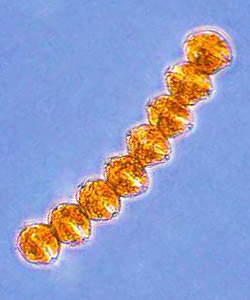 A chain of dinoflagellates in the genus Alexandrium (Source: Brian Bill, NOAA Northwest Fisheries Center) Upwelling events, which bring nutrients the surface waters in spring and summer, do occur during winter, when winter storms are followed by strong north to northwest winds. However, during January or February, any deep water that is brought up to the surface by upwelling is likely to be just as depleted in plant nutrients as the water already at the surface. Thus, upwelling events in winter are much less likely to stimulate phytoplankton blooms. Populations of diatoms (the most important type of phytoplankton on the Central Coast) reach their lowest levels of the entire year in January. However, other microscopic algae, called dinoflagellates, occasionally form dense blooms in winter. Some of these winter dinoflagellate blooms may be triggered by storm runoff carrying fertilizers, sewage, and other organic material. Another factor that may favor dinoflagellates during the winter time is that many species have tiny, hair-like flagella, which wiggle like little propellers, propelling the dinoflagellates through the water. Because they can swim up toward the surface during the daytime, dinoflagellates may be able to stay in the sunlit surface waters despite winter's downwelling and turbulent mixing. Dinoflagellates are most likely to bloom in sheltered areas close to shore—near the Golden Gate and in the northeast corner of Monterey Bay, for example. During December and January, dinoflagellates such as Peridinium trochoideum and Alexandrium splendens may bloom in Monterey Bay, and occasionally form large populations. By early February, however, nutrient levels in the bay typically drop to their lowest levels of the year, as do overall populations of dinoflagellates. The first spring diatom blooms 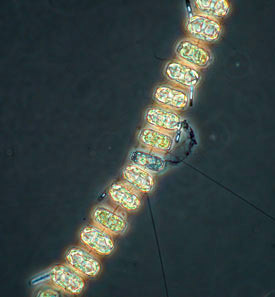 A chain of Thalassiosira aestivalis diatoms under the microscope. (Source: UCSC/CIMT) Things begin to change in late February or early March, when the California current moves toward the coast, bringing cold, nutrient-rich water up to the continental shelf. At the same time, increasing sunlight and a more stable water column allows a warmer layer of water to form near the sea surface. This sets the stage for the first early spring upwelling events, as strong northwest winds begin to follow late winter storms (more on this in March). The nutrients brought to the surface by such early upwelling events may trigger the first significant diatom blooms of the year along the open coast and the exposed portions of Monterey Bay. Late February diatom blooms typically consist of large, "weedy" diatom species, such as Skeletonema costatum and Thalassiosira aestivalis. Both these diatoms spend the winter months in a dormant state, and thus get an early start as soon as adequate sunlight and nutrients become available. In fact, the species name aestivalis means “one who hibernates."
Fish eggs and larvae dominate the plankton During January and February, if you place a few drops of Monterey Bay sea water under a microscope, you are likely to see lots of little round dots. Most of these dots are fish eggs, which are particularly abundant in the bay during late winter. You may also see strange animals that look like miniature tadpoles with big eyes. These are newly hatched fish larvae. The fish larvae will reach peak numbers in February or March (after all the eggs hatch), and will continue to be an important part of the zooplankton through June. Fish larvae are just one of the many types of tiny, drifting animals (zooplankton) that live in Central Coast waters. During early spring, fish larvae share the water with other temporary drifters such as the larvae of crabs, barnacles, sea stars, and many other animals that, as adults, will live on the seafloor, in tide pools, or in the kelp beds. Other types of zooplankton, such as tiny copepods and larger krill, spend their entire lives drifting in the open ocean. These animals will become more numerous and play a larger role in Central Coast food webs later in spring, during April and May. Fish eggs and larvae are abundant in Central Coast waters during January and February because many coastal fishes spawn between December and February. The most important of these winter-spawning fish are rockfish, anchovies, and lampfish (which are similar in size as anchovies but live in deep water). These fish larvae will spend anywhere from several weeks to several months drifting near the sea surface. As they mature, the larvae must eat almost continuously to survive. This means that the water around them must contain dense patches of microscopic algae or smaller animals on which the larvae can feed. How changes in the weather affect drifting algae and animals
The southeast winds that accompany storms in January and February generate currents that push drifting algae and animals toward shore. Thus, fish eggs and larvae that are released in winter tend to stay closer to home. In contrast, the northwest winds of spring often carry drifting algae and animals far away from shore. In general, the longer and farther from shore such animals drift, the more likely they are to be eaten or to starve to death. The young of some fish reduce the chances that they will be carried far offshore by spending a relatively short amount of time (perhaps a month or two) drifting with the currents. Other fishes, such as sculpins and greenlings, have eggs and young that do not rise toward the surface, but remain on or near the seafloor. The larvae of these fish are apparently are able to remain near the coast, despite the effects of upwelling currents. More about this in March. Many Central Coast fish release larvae just before or during the first upwelling events of the spring. During years when upwelling begins earlier, the fish give birth earlier. Thus, if the northwest winds begin in late February, lots of fish eggs and larvae are likely to be drifting around Central Coast waters, providing food for larger animals. Conversely, if upwelling is late or weak, fewer fish larvae may be found in Central Coast waters. Winter-spawning rockfish give birth As the sea surface roils and heaves during January and February storms, 150 feet down on the muddy continental shelf, life goes on as usual. In fact, winter is a busy time for deep seafloor animals. Many deep-sea fish and crabs mate in early winter and then give birth in January and February. 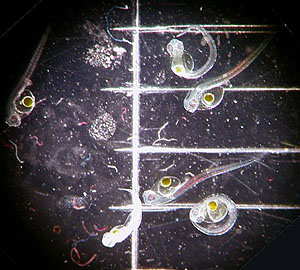 Newly hatched rockfish larvae (about 1/16-inch long). (Source: David Csepp, NMFS/NOAA) The most common and familiar of these deep-sea fishes are the rockfish. If you see a fish labeled "snapper" or "red snapper" in a California grocery store, chances are you're looking at a rockfish. In fact, there are dozens of different species of rockfish, and they support one of the most important fisheries on the California coast. Many local rockfish give birth in the darkness of the outer continental shelf during the depth of winter. These “winter spawning” rockfish include:
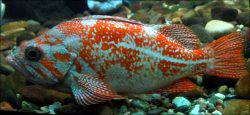 A vermilion rockfish (Source: US EPA) Vermilion rockfish (Sebastes miniatus) are fairly typical of winter-spawning rockfish, and are perhaps the quintessential red snapper (though many rockfish are red in color). They also make up a substantial portion of all the rockfish caught off California. Small schools of vermilion rockfish cluster around rocky outcrops near the edge of the continental shelf, in water about 200 to 600 feet deep, with the older, larger fish in the deeper part of this range. From their “home base,” vermilion rockfish prowl the surrounding seafloor, ambushing unwary octopus or smaller rockfish. Sometimes they swim up from the seafloor to pursue market squid, krill, anchovies, or lanternfish. Vermilion rockfish can live to be 25 years old, and don't mate until they are about eight years old. After mating in fall, female vermilion rockfish carry eggs within their bodies for several months. The eggs hatch within the mother's body, so she eventually gives birth to live young). In December or January, each female vermilion rockfish gives birth to about a million microscopic larvae. Within minutes, these larvae swim off and spend the next month or two near the sea surface. There they eat copepods and small fish larvae (including those of their own kind). The tiny vermilion rockfish larvae grow rapidly. By February or March, they are already beginning to settle down to the seafloor. Because the larvae settle out of the surface waters just before upwelling begins, they reduce the chance that they will be carried far offshore by upwelling currents. Schooling fish release eggs Like the rockfish, several species of schooling fish spawn in January and February. Some of these fishes, such as hake and lampfish, spawn in deep water. Others, such as anchovies and herring, spawn near shore and in large estuaries such as San Francisco Bay. Anchovies begin spawning 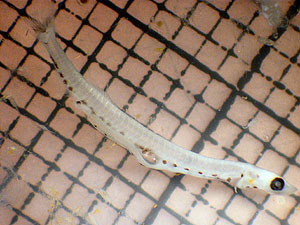 Anchovy larva (about 3/8 inch long) (Source: Fisheries and Oceans Canada) Northern anchovies (Engraulis mordax) are a coastal fish that live and spawn near the ocean surface. Anchovies spawn all year, but along the Central Coast, their peak spawning period is from February through April. Many anchovies gather to spawn in relatively protected waters such as Monterey Bay and especially the Southern California Bight, as well as in large estuaries such as San Francisco Bay. In Monterey Bay, some anchovies gather to spawn just outside the mouth of Elkhorn Slough, where their eggs and young will be sucked into the slough on the incoming tide. This results in huge numbers of young anchovies in the slough waters, but no adults. Adult anchovies also gather just outside San Francisco Bay in February and March. These anchovies appear to have a later spawning schedule. They migrate into the bay in April and then spawn in the bay's protected waters during May and June . Note:Anchovies also gather off coastal estuaries from Oregon to British Columbia, where they spawn later in the year, between June and August. Anchovy eggs hatch a day or two after being released. For the first three days, the young anchovies don't need to eat anything, but carry a large yolk sac that serves as a “bag lunch.” Once this is used up, however, the young fish must find very dense populations of prey, and feed almost continuously to survive. Though adult anchovies are omnivores, young anchovies hunt young copepods and sometimes dinoflagellates (microscopic swimming algae). There number of anchovies born each year varies immensely. Large numbers of young anchovies can survive only if they find dense patches of algae of the right size available at exactly the right time of year when they are beginning to feed. The optimum conditions for anchovies are those that favor blooms of large diatoms (described above). If upwelling is very strong, algal blooms may be dominated by smaller diatoms, which might not provide sufficient nutrition for anchovy larvae. If upwelling is too weak, dinoflagellates may bloom. These can provide good food for anchovy larvae, but may be too patchy to provide a reliable food source. Note: In the course of the year, herring and anchovies alternate using San Francisco Bay as a nursery area--herring release eggs during the winter months and anchovies release eggs in spring and summer. In late February, as northern anchovies are gathering offshore of San Francisco Bay in preparation for spawning, herring are just leaving the bay. Herring are covered in greater detail under Coastal Estuaries in January and February. Hake spawn 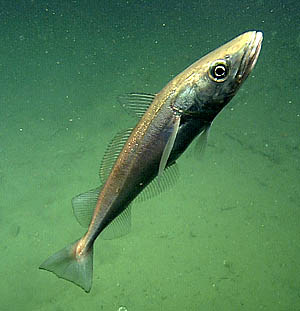 Adult hake (about 16 inches long) (Source: MBARI) In contrast to anchovies and herring, Hake (Merluccus productus) live and spawn in deep water, far from shore. Hake are a very common fish in the outer Central Coast waters, from 20 to 250 miles offshore, but they spend most of their time 500 to 1,500 feet below the surface. Larger hake sometimes congregate near the seafloor. Hake spawn from January through March, releasing eggs far below the ocean surface. Because the hake eggs are released in late winter, they are often carried northward along the coast by the Davidson Current.  Newly hatched hake larva (about 1/4 inch long) (Source: Fisheries and Oceans Canada) After hake eggs hatch, the young larvae eat copepod eggs or dinoflagellates, if the latter are available. Over the next few months, as young hake grow larger, they progress to eating copepod larvae, and eventually adult copepods, which become more abundant later in spring. This is one of many situations in the ocean in which young predators and their prey develop in synchrony as they drift together in the plankton. Hake populations, like those of anchovies and rockfish, go through extreme booms and busts. Thus, the number of hake larvae in the zooplankton may be hundreds of times higher during good years than during bad years. Those hake born during good years tend to dominate the hake populations for five to seven years afterward. 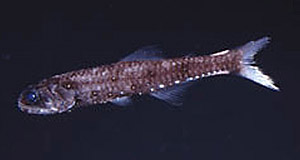 Northern lampfish (about four inches long) (Source: MBARI) 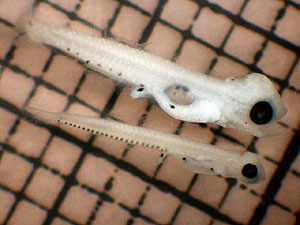 Northern lampfish larvae (about 1/4 inches long) (Source: Fisheries and Oceans Canada) Lampfish spawn During December or January, Northern Lampfish (Stenobrachius leucopsarus) migrate toward near shore and then release their eggs in the coastal waters. Within Monterey Bay, lampfish larvae are most abundant in the plankton between January and March. Though rarely seen by humans, huge schools of lampfish live off the Central California coast, 2,000 to 3,500 feet below the surface. Some lampfish swim up toward the surface at night to hunt copepods, krill, and small fishes. Note: As their name implies, lampfish have lines of glowing organs on their sides and bellies; each species has a different pattern of lights. King salmon congregate off the Golden Gate With vast schools of anchovies and herring swimming around just outside the Golden Gate, it's not surprising to find predators taking advantage of this seasonal concentration of tasty little bait fish. Chief among these predators are king salmon (Oncorhynchus tshawytscha ). In February and March, three-year-old king salmon congregate in the Gulf of the Farallones (between Bolinas and San Pedro Point). Over the next nine months, these salmon will gorge on the bait fish, crab larvae, and krill that also congregate in this coastal area. Come the first rains of fall, they will swim into the bay and then work their way upstream to lay eggs in the Sacramento River Delta and (if they are lucky) the streams of the Sierra foothills . Note: Just as the salmon gather outside the golden gate to catch anchovies and herring, so the salmon fishermen gather outside the golden gate in early spring to catch king salmon. Seafloor predators give birth 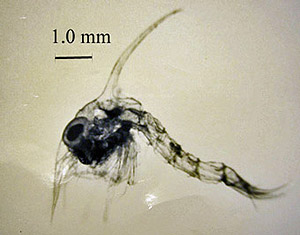 Dungeness crab larva - zoea stage (about 1/8 inch long). The spine on its back may discourage predators (Source: Oregon Department of Fish and Wildlife) Like the rockfish and thornyheads, other seafloor predators give birth in January or February. Dungeness crab (Cancer magister) is another seafloor predator and favored food item for humans that releases its young in the dead of winter. Between November and January, each female crab has been carrying between one and two-million eggs, tucked underneath a flap on her belly. Some time between late December and early March, these eggs hatch, releasing microscopic crab zoea (larvae) into the surrounding water. These Dungeness crab larvae will spend the next three to five months drifting in the open ocean. During the daytime, they submerge to depths of 80 feet or so, but at night they migrate up to the surface, where they feed first on diatoms and then copepods. The crab larvae will pass through five zoeal stages and 1 megalops stage before assuming their final form and settling to the bottom in May. Because Dungeness crab larvae spend such a long time drifting around near the surface at the height of the upwelling season, they are very likely to be carried far offshore by upwelling currents. Sometimes they even attach themselves to surface-living jellies such as "By-the-wind-sailors" and hitchhike on these animals until the time comes to return to shore. Dungeness crab larvae seem to require cold water (50-55 deg. F) in order to feed and survive. This need for cold water limits their range to north of Point Conception. Strong upwelling and the resulting cold water also seem to correlate with years of abundant food for Dungeness crab larvae, when a higher proportion of larvae survive and develop into adults. 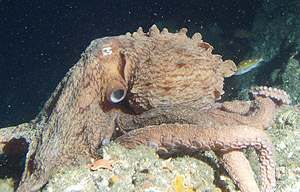 Giant Pacific Octopus (Source: Bob Lea / SIMoN NOAA) The Giant Pacific octopus (Octopus dofleini) is another seafloor predator that broods its eggs through the winter months and then releases young in early spring, just before upwelling starts. In fall, each female octopus lays tens of thousands of pale yellow or green teardrop-shaped eggs and attaches them to the ceiling of her lair. By February, the female octopus has guarded these eggs for five to seven months. During all this time, she does not eat, and her body gradually becomes wrinkled and weak. About the time her eggs hatch, she will die. When the eggs finally hatch, hundreds of little larval octopus swim up toward the surface. Unlike many larvae, these actually look like tiny transparent octopuses. About a quarter inch long when they hatch, the larvae spend about a month or two drifting around in the surface waters. During their time in the plankton, 99% of the tiny octopuses are eaten. Those few that do survive grow to about two inches long and sink back down to the seafloor in March or April. They only live a few years, but by the time these youngsters are ready to reproduce, they will be six feet or more across. 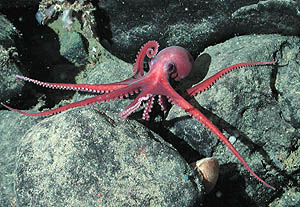 Red octopus live even in the deep waters of Davidson Seamount, thousands of feet below the sea surface. (Source: MBARI) Another, smaller type of octopus, the red octopus (Octopus rubescens) has a reproduction schedule that is about six months out of phase with that of the giant octopus. In February, when the giant octopus eggs are just hatching, red octopus are mating in the deep water of the outer continental shelf. Mating is a tricky business for the red octopus (as it is with many cephalopds). They are basically solitary animals. The only time two octopus interact in a non-hostile manner is during mating. Even then, there is a strong chance that the male will lose part or all of a tentacle. In the long run, loosing a tentacle doesn't matter very much to the male octopus because he dies shortly after mating. The female survives another six months or so, allowing her to move into shallow water, (in late spring), lay eggs (in summer and fall), and guard them until they hatch in late fall. |

